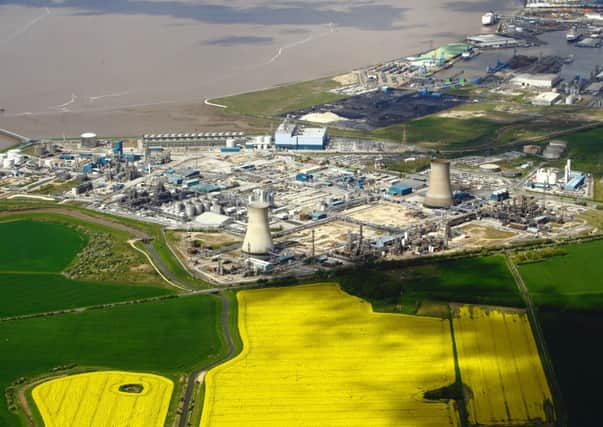A celebration of 100 years as sector proves a world leader


On May 27, 1914, the SS Artemis docked at the newly-constructed jetty at Saltend to the east of Hull with a shipment of 3,000 gallons of benzene, to mark the start of industrial operations on the site.
Today, strategically located at the heart of the Humber – the UK’s energy estuary – Saltend Chemicals Park is superbly positioned to share in a new era of prosperity for the Humber region.
Advertisement
Hide AdAdvertisement
Hide AdThe site marked its 100th anniversary soon after the announcement of a £310m investment by Siemens and Associated British Ports (ABP) in offshore wind turbine manufacturing facilities either side of Saltend.
Furthermore, with the £350m Vivergo Fuels plant at Saltend one of Europe’s biggest producers of the green fuel, bioethanol, and Kingston Research Ltd developing the new generation biofuel, biobutanol, also on site, the chemicals park is already a major contributor to the Humber’s credentials as the UK’s renewables region.
Business development manager Diana Taylor said the Humber’s growing profile created a positive backdrop for the chemicals park’s work to market the site as a major opportunity for inward investment.
“This site and the region have a fantastic future, building upon our wonderful location, experience, capability and great people,” she said. “The Humber can become established as a centre of excellence for renewables, energy generation and future manufacturing processes – all of them relevant to Saltend. Geographically, we are also at the heart of the area which will see so much investment. There is a great opportunity for Saltend to prosper as the region prospers.”
Advertisement
Hide AdAdvertisement
Hide AdThe site’s origins were in the growing demand for oil in the lead up to the First World War. That led to the construction of a wooden jetty projecting 1,500 feet into the Humber, beginning the story of Saltend as a major industrial site. The first businesses on site were the Asiatic Petroleum Company (later to become Shell) and the Anglo Mexican Company (Shell Mex), to be joined in 1921 by BP when it opened a depot to establish its first presence on site.
Now the operator of the chemicals park, with two world-scale plants on site, BP has been represented at Saltend for all but seven years of the site’s history.
In 1924 Saltend saw the beginning of a new enterprise – manufacturing industrial alcohol. For more than four decades production of alcohol for industrial processes, by Distillers Company Ltd, was the primary activity at Saltend. BP’s purchase of the site from Distillers in 1967 accelerated Saltend’s transformation from primarily a distillery to large-scale chemicals manufacturing. The following years saw major investments across the site, including, in 1982, when production began at BP’s state-of-the-art A4 acetic acid plant.
Saltend was becoming a world-scale industrial location attracting massive investment not just by BP, but other major companies who recognised the site’s advantages and potential. Mineral fertilisers producer Yara and industrial gases company Air Products were the pioneers of today’s multi-user environment.
Advertisement
Hide AdAdvertisement
Hide AdConstruction of a 1200MW power station, which was completed in 2000, added to the site’s attractiveness to investors and the following years saw Nippon Gohsei, a producer of barrier packaging, petrochemicals giant INEOS and bioethanol producer Vivergo Fuels all invest at Saltend.
In 2009 Saltend’s development as a multi-operator site was formally recognised with the creation of Saltend Chemicals Park as an umbrella for the integrated cluster of businesses. The change ushered in a new era of collaboration and partnership, with the chemicals park offering a range of reliable, cost-effective utilities and services to businesses across the site.
The change has been well received by businesses that have prospered at Saltend, among them Vivergo Fuels, whose capital investment was greater even than that proposed by Siemens and ABP.
Vivergo Fuels chose Saltend because of access to the region’s wheat belt; the deep-water location on the Humber for biofuel exports; and the chemicals park’s excellent infrastructure and facilities, including electricity and steam from the on-site power station. The Vivergo Fuels plant was officially opened in July 2013 by Business Secretary Vince Cable.
Advertisement
Hide AdAdvertisement
Hide AdVivergo Fuels operations director Andy Bulman said: “Saltend Chemicals Park has proved to be a great location for our world-scale biofuels business, due to its prime position, existing infrastructure and the expertise of site partners. We look forward to playing a part in the park’s future success.”
Japanese-owned Nippon Gohsei is now a well-established Saltend success story. It began operations at Saltend in 2004, establishing a £100m facility producing the world-leading packaging product Soarnal.
In 2011 Nippon Gohsei teamed up with Hull-based Neill & Brown Global Logistics to create a shared facility at Marfleet, close to Saltend, dedicated to the distribution of Soarnal, with additional production and laboratory facili- ties.
Then, last year, the company boosted production capacity at Saltend from 15,000 to 18,000 tonnes a year, by ‘de-bottlenecking’ processes.
Advertisement
Hide AdAdvertisement
Hide AdNippon Gohsei site director Peter des Forges said: “Nippon Gohsei UK Limited has been based on Saltend Chemicals Park for more than 10 years. During this time we have utilised the services and facilities on the park to enable us to expand our business and attract over 100 highly-skilled local people.”
John Meehan is a former editor of the Hull Daily Mail. He now owns Meehan Media & Comms.